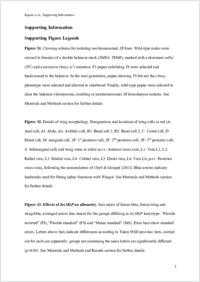Parallel effects of the inversion In(3R)Payne on body size across the North American and Australian clines in Drosophila melanogaster
- Kapun, Martin Department of Ecology and Evolution, University of Lausanne, Lausanne, Switzerland
- Schmidt, C. Department of Ecology and Evolution, University of Lausanne, Lausanne, Switzerland
- Durmaz, E. Department of Ecology and Evolution, University of Lausanne, Lausanne, Switzerland
- Schmidt, P. S. Department of Biology, University of Pennsylvania, Philadelphia, PA, USA
- Flatt, Thomas Department of Ecology and Evolution, University of Lausanne, Lausanne, Switzerland
-
2016
Published in:
- Journal of Evolutionary Biology. - 2016, vol. 29, no. 5, p. 1059–1072
English
Chromosomal inversions are thought to play a major role in climatic adaptation. In D. melanogaster, the cosmopolitan inversion In(3R)Payne exhibits latitudinal clines on multiple continents. As many fitness traits show similar clines, it is tempting to hypothesize that In(3R)P underlies observed clinal patterns for some of these traits. In support of this idea, previous work in Australian populations has demonstrated that In(3R)P affects body size but not development time or cold resistance. However, similar data from other clines of this inversion are largely lacking; finding parallel effects of In(3R)P across multiple clines would considerably strengthen the case for clinal selection. Here, we have analysed the phenotypic effects of In(3R)P in populations originating from the endpoints of the latitudinal cline along the North American east coast. We measured development time, egg‐to‐adult survival, several size‐related traits (femur and tibia length, wing area and shape), chill coma recovery, oxidative stress resistance and triglyceride content in homokaryon lines carrying In(3R)P or the standard arrangement. Our central finding is that the effects of In(3R)P along the North American cline match those observed in Australia: standard arrangement lines were larger than inverted lines, but the inversion did not influence development time or cold resistance. Similarly, In(3R)P did not affect egg‐to‐adult survival, oxidative stress resistance and lipid content. In(3R)P thus seems to specifically affect size traits in populations from both continents. This parallelism strongly suggests an adaptive pattern, whereby the inversion has captured alleles associated with growth regulation and clinal selection acts on size across both continents.
- Faculty
- Faculté des sciences et de médecine
- Department
- Département de Biologie
- Language
-
- English
- Classification
- Biological sciences
- License
- License undefined
- Identifiers
-
- RERO DOC 324334
- DOI 10.1111/jeb.12847
- Persistent URL
- https://folia.unifr.ch/unifr/documents/307619
Other files
Statistics
Document views: 108
File downloads:
- 2016_pei.pdf: 164
- 2016_pei_sm.pdf: 119

